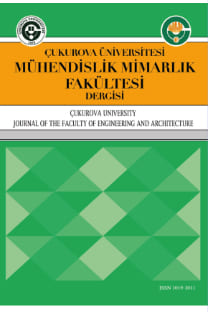Atık pet agregalı ve cüruflu hafif harçların dayanım özellikleri
Strenght properties of lightweight mortars with waste pet aggregates and slag
___
- 1. Carless,J., “Taking Out the Trash: a mo-nonsense Guide to Recycling”, Washington, D.C., Island Press, 1992.
- 2. Tokyay,M., “Cüruflar ve Cüruflu Çimentolar: Arastırmaların Gözden Geçirilmesi ve Durum Değerlendirmesi Raporu”, TÇMB, Ankara, 2003.
- 3. Ohama,Y., Madej,J., Demura,K., “Efficiency of Finely Ground Blast Furnace Slags in High-Strength Mortars”, Milwauke Conference, 1995.
- 4. Geiseler,J., Kollo,H., Lange,E., “Influence of Blast-Furnace Cements on Durability of Concrete Structures”, ACI Material Journal, 92 (23), 252 –257, 1995.
- 5. Soroka,I., “Concrete in Hot Environments”, National Building Research Institue, Faculty of Civil Engineering, Technion-Đsrael Institute of Technology, Haifa, 1993.
- 6. Shehata,I., Shahram,V., Elsawy,A., Fahmy,M., “The Use Of Solid Waste Materials as Fine Aggregate Substitutes in Cementitious Concrete Composites”, Semisequicentennial Transportation Conference Proceedings, Iowa State University, Iowa, 1996.
- 7. Choi,Y.-W., Moon,D.-J., Chung,J.-S., Cho,S.-K., “Effects of Waste PET Bottles Aggregate on the Properties of Concrete”, Cement and Concrete Research 35, 776-781, 2005.
- 8. Gavela,S., Karakosta,C., Nydriotis,C., Kaselour,-Rigopoulou,V., Kolias,S., Tarantili,P.A., Magoulas,C., Tassios,D., Andreopoulos,A., “A Study of Concretes Containing Thermoplastic Wastes as Aggregates”, ID 270, Conference on the Use of Recycled Materials in Building and Structures, Barcelona, Spain, 2004.
- 9. Mahmoud,A., Halim,A.-G., “Structural Material from Waste Plastic”, Journal of Applied Polymer Science, 91, 2543–2547, 2004.
- 10. Al-Maneer,A.A., Dala,T.R., “Concrete Containing Plastic Aggregates”, Concrete International, 19 (8), 1997, 47-52, 1997.
- 11. ACI Committee 213R, “Guide for Structural Lightweight Aggregate Concrete”, Manual of Concrete Practice, 1987.
- ISSN: 1019-1011
- Yayın Aralığı: 4
- Başlangıç: 1986
- Yayıncı: ÇUKUROVA ÜNİVERSİTESİ MÜHENDİSLİK FAKÜLTESİ
Yener BÜLBÜL, Mehmet Ekrem Cakmak, SERPİL SAVCI, Mesut BAŞIBÜYÜK
HALİL GÖRGÜN, Senem YILMAZ, Orhan AKSOĞAN
Genetik algoritmayla vidalı kriko elemanlarının optimizasyonu
Faruk MENDİ, M. Kemal KÜLEKCİ, Durmuş Ali BİRCAN, Tamer BAŞKAL
Eski eserlerde meydana gelen taş bozulmalarının Adana'da örneklenmesi
SEMİHA AKÇAÖZOĞLU, KUBİLAY AKÇAÖZOĞLU, Fatih ÖZCAN
UĞUR EŞME, İREM ERSÖZ KAYA, ARİF ÖZBEK, Funda KAHRAMAN, Aysun SAĞBAŞ
Investigation of the biosorption characteristics of basic blue 41 by live activated sludge
Hamza Alkan ARSLAN, Mehmet Ekrem Cakmak, OLCAYTO KESKİNKAN, Mesut BAŞIBÜYÜK
Genetik algoritma (G.A.) yardımıyla helis dişli çarklarda optimum modül seçimi
Faruk MENDİ, M. Kemal KÜLEKCİ, Tamer BAŞKAL, Durmuş Ali BİRCAN
Türkiye'de temel ekonomik göstergeler ve sanayi sektörü-I: genel değerlendirme
